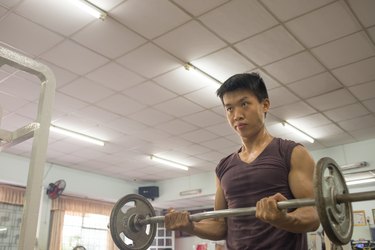
A common complaint from performing a heavy set of biceps curls is a sore neck; this typically happens when you don't follow proper form for the exercise. Understanding the proper form in relation to what you did to injure your neck can help you to avoid or prevent injury to your neck from biceps curls in the future.
Proper Form
Video of the Day
Stand with your feet just inside shoulder-width apart. Grab the barbell, dumbbells or straight bar with an underhand grip, with your hands shoulder-width apart. Straighten out your arms and allow them to hang toward the floor with the barbell resting against your thighs. Retract, or bring together, your shoulder blades slightly so your shoulders are centered laterally across your upper body. Face directly ahead and move your head back so it is centered over your spine. Jam your elbows against your ribcage and pull the bar or dumbbells, raising it upward by bending at your elbows. Continue moving the bar upward while keeping your head in a neutral position with your shoulder blades retracted and your elbows against your sides. Once the bar is 1 inch away from your shoulders, relax and return the bar slowly to your thighs.
Video of the Day
Neck Injury Form
Neck injury when performing biceps curls often occurs when you begin to fatigue as your body tries to compensate for biceps failure. Your body's natural reaction is to include muscles other than your biceps to complete the lift. Tilting your head downward to look at the bar and relaxing your shoulder blades will cause neck muscles -- upper trapezius, sternocleidomastoid and splenius -- to activate with the lift. These neck muscles are responsible for neck extension and rocking your neck backward. By looking down, then pulling back with your head, your neck muscles assist the biceps in pulling the weight; however, this places a lot of strain on your neck muscles and spinal column. This causes the neck muscles to over-exert and leads to a neck strain or cervical spine damage.
Accommodation Leads to Stress
Using poor form has other negative consequences beside a sore neck. It reinforces poor mechanics during the biceps curl exercise. Using poor mechanics can result in movement patterns that can increase the chances of injuring your neck during exercise. Neck muscles adapt to poor form and become stronger; however, as they assume more of the workload during exercise they experience greater stress. Poor form also de-emphasizes the work on your biceps — which means that you're not meeting the intended goal of the biceps curl exercise.
Neck Injury Recovery
Virginia Tech University's Schiffert Health Center reports that recovery from a neck strain typically takes 48 to 72 hours after the injury. If you experience headache, numbness or weakness, contact your doctor immediately. If you feel the injury occur when performing the exercise, stop immediately and apply a bag of ice to the injured neck muscles to minimize swelling and pain. Anti-inflammatory medication can combat swelling and reduce pain; however, consult your doctor to ensure that anti-inflammatory medications are safe for you.